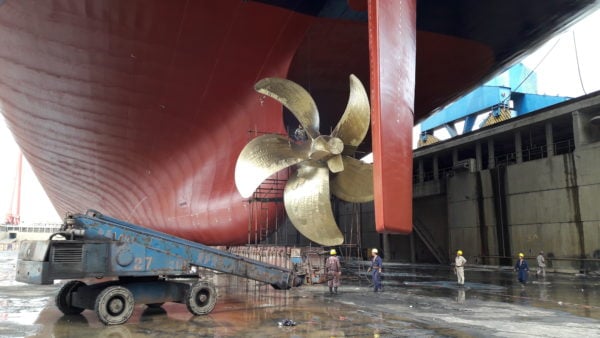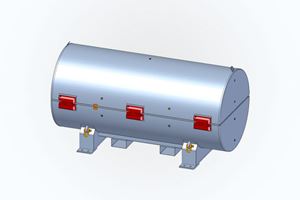Washers reduce costs in propeller assembly
During the worst shipping crisis in history, Mecklenburger Metallguss reinvented the ship propeller to help the world’s largest container ships sail through the storm.
It’s late in the evening and heavily loaded lorries escorted by police cars, blue lights flashing, move through the sleepy town of Waren, north-eastern Germany. Yet the residents of the quaint little houses aren’t worried; they know it’s just another ship propeller about to leave town. Waren, with some 20,000 inhabitants, is home to Mecklenburger Metallguss GmbH (MMG) – a world leader in the design and production of propellers for large container ships. One of its crea-tions, a 131-ton, huge six-blade propeller for Maersk, holds the world record for the largest ship propeller.
It’s a tricky transport challenge. Hamburg, Germany’s largest sea-port, is more than 200 kilometres away and stopping on the autobahn is time-consuming for the convoy of long and heavy vehicles. Some years ago, a whole A-road, along with two railway tracks, had to be moved as the company grew and propeller transports kept jamming the traffic. So, what is an XXL ship supplier like MMG doing this far from the sea?
“We started manufacturing propellers 70 years ago, as the area was a Soviet occupation zone and the East German ship building industry had to be rebuilt after the war,” explains Jörn Klüss, Head of Design and Construction at MMG and a Waren native. “Back then, ship propellers were a lot smaller. Today, the know-how in the region is what makes us stay.”
CARGO CAPACITY has grown 1,200 percent over the past 40 years. Fifteen years ago, ships moved 5,000 TEU (twenty foot equivalent unit, a standard 6.1-metre shipping container). Today, ultra-large container ships load 22,000 TEU.
However, container demand collapsed during the financial crisis in 2009, and orders for new propellers stopped. “What saved us was our ‘Retrofit’ programme,” says Klüss, “a new generation of propellers that optimises efficiency in old ships.”
UNTIL THEN, propellers were built for ships operating at the highest possible speed. After the crisis, ships started slow steaming with engines running below capacity to cut fuel consumption. Ships that used to cross the oceans at 25 knots (46.3 km/h) slowed down to 18 knots (33.3 km/h) or less. “The slower an engine runs, the larger you can go on the propeller,” explains Klüss. “By analysing individual operating profiles, we adapt the number of blades and the diameter to determine the most efficient individual propeller.”
The company also analysed the propeller cap – the part of the propeller behind the blades that protects the steel components of the propeller shaft from seawater corrosion. It created a new energy saving cap (MMG-escap) with a new fin design that straightens the hub vortex, reducing the required torque and preventing wear on the rudder. These innovations made it possible to increase efficiency by up to 10 percent, sav-ing roughly EUR 200,000 for an Asia-Europe voyage.
MANY SHIPPING COMPANIES showed interest in upgrading old propellers with the MMG-escap, which alone increases propulsion system efficiency by up to 3 percent. Conventionally, propeller caps are fitted to the propeller with bolts secured by a chemical locking adhesive. But this requires the ship to dock for at least three days, incurring docking fees of about USD 15,000 per day, plus the cost of removing the ship from its sailing schedule. “We started thinking about attaching the new cap underwater, using divers,” says Klüss. “But that excludes the use of adhesives, which need oxygen to harden. That is how we found out about wedge-locking washers and the inventor of this technology – Nord-Lock.”
HOWEVER, the strictly regulated shipping industry relies on classification societies to ensure safety at sea and define technical standards for ship construction and operation. A ship cannot operate without classification, as it won’t get insurance or freight orders. The Nord-Lock washers hadn’t been tested and approved for use with the special copper alloy used in the propeller cap, so a certification that the washers efficiently secured the propeller cap was urgently needed. Every ship building country has its own classification organisation, and MMG works with all of them. In this case, they contacted DNV GL, one of the largest.
“If the shipping company and classification society agree, you may implement an application and perform a subsequent verification,” explains Klüss. “The Nord-Lock washers already had multiple certifications and DNV GL was motivated to test for another one due to our innovative steel-copper alloy combination.”
THE FIRST UNDERWATER ASSEMBLY of a propeller cap with Nord-Lock washers was carried out in 2014 on a large European container ship. Three divers only needed 1.5 days to do it during regular port time and without docking fees – a success. MMG, DNV GL and Nord-Lock met in September 2016. Less than a year later, the washers had been tested and approved.
“The shipping industry is very conservative,” says Klüss. “But we’ve convinced them of the diver solution’s merits, and Nord-Lock is now our new standard for all bolted joint applications.”

Customer: Mecklenburger Metallguss GmbH.
End customers: Shipping companies across the globe, ship yards mainly in Asia.
Location: Waren (Müritz) in Mecklenburg-Vorpommern, Germany.
Application: Securing a ship propeller cap with Nord-Lock washers instead of adhesives.
The solution: SMO washers for stainless steel bolts.
Benefits gained:
■ Excellent locking reliability.
■ Reduction of assembly errors thanks to ease of use.
■ Possibility to fix the propeller cap to an existing propeller under water.




